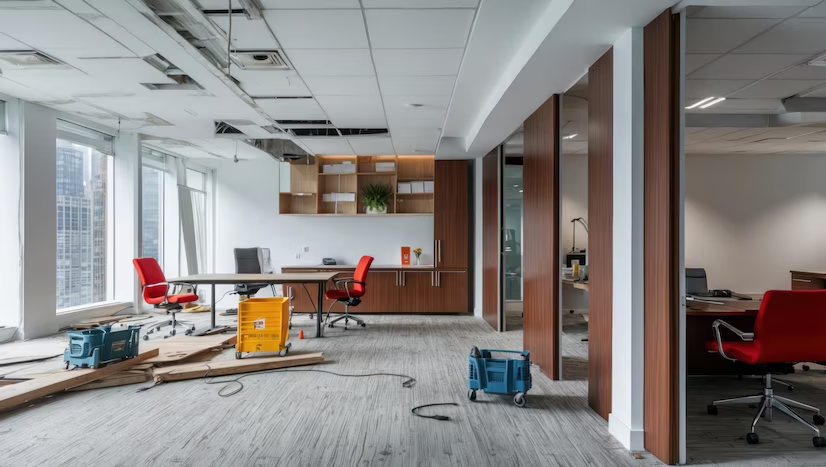Renovating an office is an exciting endeavor that can significantly enhance productivity, aesthetics, and employee satisfaction. However, managing the costs associated with an office renovation requires careful planning and strategic budgeting. To ensure your office renovation stays within financial limits and meets your objectives, here’s a comprehensive guide on creating a budget, prioritizing expenses, and avoiding common financial pitfalls.
Understanding Renovation Costs
Types of Costs
Office renovation costs can be broadly categorized into direct and indirect expenses. Direct costs include construction work, materials, and labor. Indirect costs encompass permits, design fees, and administrative expenses. Understanding these categories helps in creating a more accurate and comprehensive budget.
Factors Affecting Costs
Several factors influence renovation costs. The size and scope of the renovation play a significant role—larger spaces and more complex projects will naturally incur higher costs. The quality of materials and finishes also affects the budget. Higher-end materials and finishes will increase costs, but they might offer better durability and aesthetics. Additionally, location and logistical considerations can impact expenses, particularly if the renovation involves complex site access or compliance with local regulations.
Creating a Renovation Budget
Assessing Your Needs and Goals
Start by clearly defining the objectives of your renovation. What are the primary goals? Are you looking to enhance employee productivity, improve aesthetics, or integrate new technologies? Prioritizing these goals will help you allocate resources effectively and ensure that essential aspects of the renovation receive adequate funding.
Research and Estimates
Accurate budgeting requires thorough research. To get a realistic understanding of the costs involved, obtain multiple quotes from contractors and suppliers. Online tools and calculators can provide initial estimates, but they should be supplemented with professional quotes. This step helps identify potential cost variances and ensures that your budget reflects the true scope of the project.
Allocating Funds
Break down your budget into key categories: design, construction, furniture, and technology. Allocate funds based on the priorities established earlier. It is also wise to set aside a contingency fund to cover unexpected expenses. A general rule of thumb is to reserve 10-20% of your contingency budget. This cushion helps manage unforeseen issues like design changes or additional repairs.
Prioritizing Expenses
Essential vs. Non-Essential Upgrades
Differentiate between essential and non-essential upgrades. Focus on improvements that align with your business goals and provide the most significant impact. For instance, upgrading technology and improving workspace ergonomics might be essential, while high-end finishes or decorative elements can be considered non-essential. By prioritizing essential upgrades, you ensure that critical aspects of the renovation are completed within budget.
Cost vs. Value
Evaluate the return on investment (ROI) for various upgrades. While high-end materials or elaborate designs might seem appealing, it is important to assess their long-term value. For example, investing in energy-efficient lighting or ergonomic furniture might have a higher ROI than luxury finishes that don’t significantly impact productivity or operational efficiency.
Avoiding Common Financial Pitfalls
Underestimating Costs
One of the most common pitfalls in renovation budgeting is underestimating costs. Inaccurate cost estimates can lead to budget overruns and financial strain. To avoid this, ensure that your estimates are based on detailed and comprehensive planning. Consult with experts and use reliable cost estimation tools to refine your budget.
Overlooking Hidden Costs
Hidden costs can significantly impact your budget. These may include demolition, site preparation, and permit fees, which are often overlooked in initial estimates. Make sure to include these potential expenses in your budget and plan for them accordingly. Conduct a thorough assessment of the site and consult with professionals to identify any hidden costs that may arise.
Changes and Delays
Scope changes and project delays can disrupt your budget. It’s essential to manage changes carefully and understand their financial implications. Establish a clear process for handling modifications to the project scope and communicate these changes with your contractor. Regularly monitor the project’s progress and address any issues promptly to minimize delays and additional costs.
Tips for Staying Within Budget
Clear Communication with Contractors
Clear communication with contractors is key to avoiding misunderstandings and managing expenses. Ensure that contracts are detailed and cover all aspects of the renovation. Regularly review progress and expenses with your contractor to promptly address any issues or discrepancies. Transparent communication helps manage costs and ensure the project aligns with your budget.
Additionally, discussing commercial utilities comparison options with your contractor can provide insights into more cost-effective and energy-efficient solutions, further streamlining the renovation process and potentially reducing long-term operational expenses.
Flexible but Firm Planning
Flexibility is important, but it should be balanced with firm budget management. Be prepared to adapt to changes while maintaining a disciplined approach to budgeting. Evaluate trade-offs carefully and make informed decisions that align with your financial limits and renovation goals.
Concluding Remarks
Budgeting for an office renovation involves a strategic approach to managing costs and ensuring that financial resources are allocated effectively. By understanding the types of costs involved, creating a detailed budget, prioritizing essential upgrades, and avoiding common pitfalls, you can achieve a successful renovation that enhances your office environment without exceeding your financial limits. Careful planning and proactive management will help you navigate the complexities of renovation budgeting and achieve your desired outcomes.










 /home/u448362301/domains/theexpotab.com/public_html/wp-content/themes/foxiz/templates/popup.php on line 167
/home/u448362301/domains/theexpotab.com/public_html/wp-content/themes/foxiz/templates/popup.php on line 167